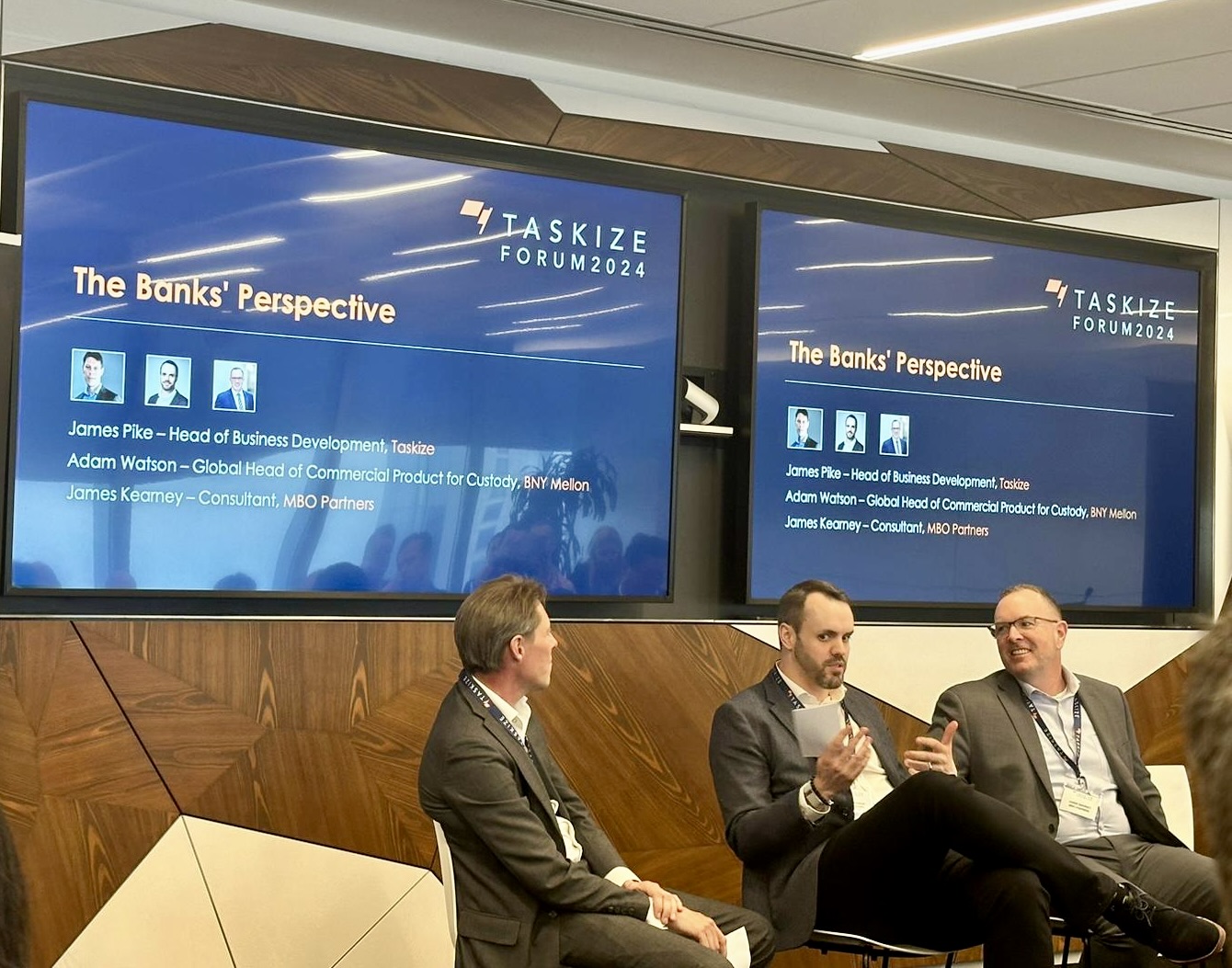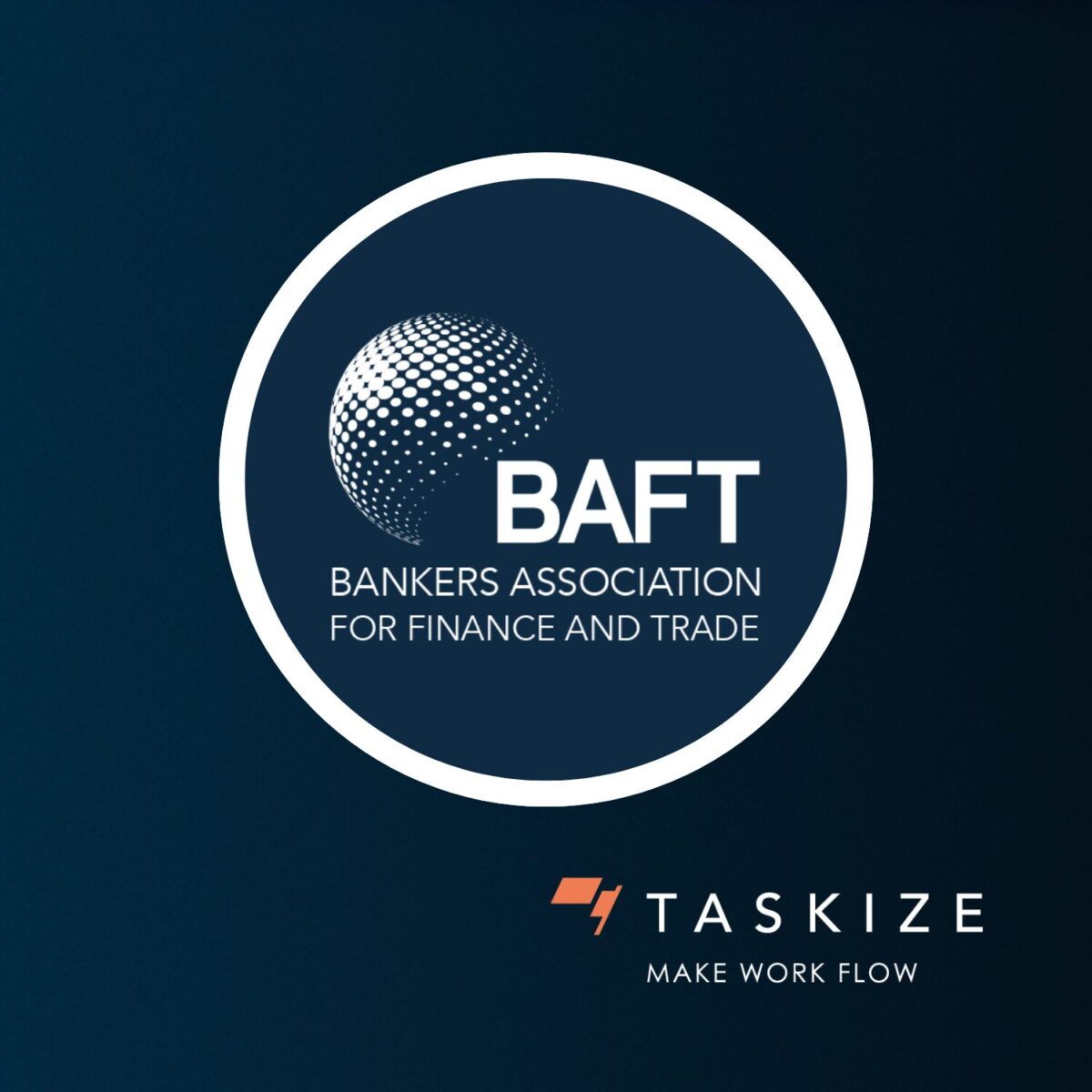Press releases
At Taskize Forum 2024 New York, industry leaders gathered to discuss the modernisation of post-trade operations and workflows.

At Taskize Forum 2024 New York, industry leaders gathered to discuss the modernisation of post-trade operations and workflows.
The first session, a fireside chat titled “The Banks’ Perspective”, gave a platform to Adam Watson (Global Head of Commercial Product for Custody from BNY Mellon), James Kearney (Consultant, MBO Partners and formerly Vanguard‘s Head of Global Investment Ops) and Taskize’s interim CEO, James Pike.
The conversation tackled the operational and regulatory challenges facing middle- and back-office functions and explored how fintechs can drive efficiency and collaboration. Here we recap the key takeaways from the conversation.
Connectivity and collaboration
For banks, the ability to connect and collaborate seamlessly across different functions and systems is critical. The conversation touched upon the significance of metrics in informing and improving operational processes, and the growing interest in sourcing functions effectively within interconnected working ecosystems:
“The ability to connect and collaborate seamlessly is becoming more crucial. Metrics not only inform but also improve our operational processes, helping us source functions more effectively within interconnected ecosystems.” – James Pike, Taskize
Adam Watson noted that too much time is spent on menial tasks, emphasising the need for better data integration to allow clients to retrieve necessary information independently. He said: “The best inquiry is one that doesn’t have to happen”.
James Pike emphasised how fintech solutions like Taskize can standardise query processes, making data access more efficient, streamlining operations and improving client service as a result:
“What you’re talking about there, Adam, is standardising an inbound query to get a data set back automatically across a range of different counterparties.”
Leveraging technology to overcome operational challenges
Adam shared his experience from BNY Mellon, focusing on the challenge of integrating clients into existing platforms. He spoke about the importance of meeting clients where they are, rather than forcing them to adapt to new systems. This approach minimises ‘swivel chair risk’, where operators waste time switching between different systems and interfaces.
By prioritising client preferences and enhancing platform interoperability, BNY Mellon has seen significant improvements in client satisfaction and operational efficiency:
“Meeting clients where they are, instead of making them adapt to our systems, is key to reducing ‘swivel chair risk.’ This approach has led to better client satisfaction and operational efficiency.”
The panelists also discussed how banks can significantly enhance operational efficiency by adopting advanced technology for handling queries and exceptions. James Kearney shared an example from his experience at Vanguard, highlighting the use of fail prediction tools:
“If I have a fail and I think it’s a fail, and you have a probability of 80% or higher that it’s going to settle in time, I should run all of my exceptions through that data.”
This predictive approach reduces unnecessary workload, allowing banks to focus on critical issues and ensuring smooth settlement processes.
Interoperability and standardisation
Interoperability was another key theme, with panelists agreeing on the need for standardised processes across the industry. Adam pointed out the value of creating an ecosystem that allows clients to work seamlessly across different platforms, whether it be Taskize, Teams, or Symphony:
“If you want to be native in Taskize, that’s great, but if I’m native in Teams or Symphony, how do I interoperate to allow you to stay where you are?”
James Kearney echoed this sentiment, stressing the need for cohesion and transparency across different functions to avoid the inefficiencies of siloed operations. He discussed the complexities of managing multiple counterparties, custodians, and internal teams: “Being able to figure out how you can find as much cohesion within a single function but also across functions”.
James also highlighted how tools like Taskize have helped streamline processes and improve communication within and between organisations:
“Cohesion and transparency across functions are crucial for efficient operations and risk management. Tools like Taskize streamline processes and improve communication, helping us manage operational risks better.”
By reducing reliance on fragmented systems and fostering a more integrated approach, banks can better handle volume fluctuations and operational risks. And by ensuring interoperability, firms can maintain their preferred systems while integrating new technologies.
The role of data
The panelists agreed that a robust data model is crucial for operational resilience in the banking sector. Adam highlighted the necessity of focusing on data to drive insights and create actionable outcomes. He stressed that without a strong data backbone, even the best-intentioned technological advancements could fall short.
The conversation also touched on the T+1 settlement cycle and how data-driven strategies can help firms adapt to these industry changes:
“A robust data model is essential for operational resilience. Without strong data, even the best technology will fall short. Data-driven strategies are vital as we move towards T+1.” – Adam Watson, BNY Mellon
Structured, transparent communication
The conversation also touched on the inefficiencies of traditional communication methods like email and chat. James Kearney illustrated how these tools often exacerbate operational opacity rather than alleviate it. He advocated for structured, transparent communication channels that ensure critical information is easily accessible and actionable:
“Traditional communication methods like email and chat can exacerbate operational opacity. Structured, transparent communication channels are essential for making critical information accessible and actionable.”
Throughout the conversation, the Taskize platform was highlighted as a valuable tool that helps banks achieve greater operational resilience and efficiency:
“I think we’re [Vanguard] fairly early on in adopting Taskize and one of the things we tried to do is not just find that consistency within a certain vertical but also how does that allow you to be a little bit more resilient across functions.” – James Kearney, formerly of Vanguard
The Banks’ Perspective fireside chat at the Taskize Forum provided a comprehensive look at the current state and future direction of post-trade operations. It reinforced the idea that modernisation is not just about adopting new technologies but about creating a cohesive, data-driven, and client-centric operational model.
Stay tuned as we unveil more insights from the Taskize Forum 2024 and continue the conversation on the modernisation of post-trade operations.



